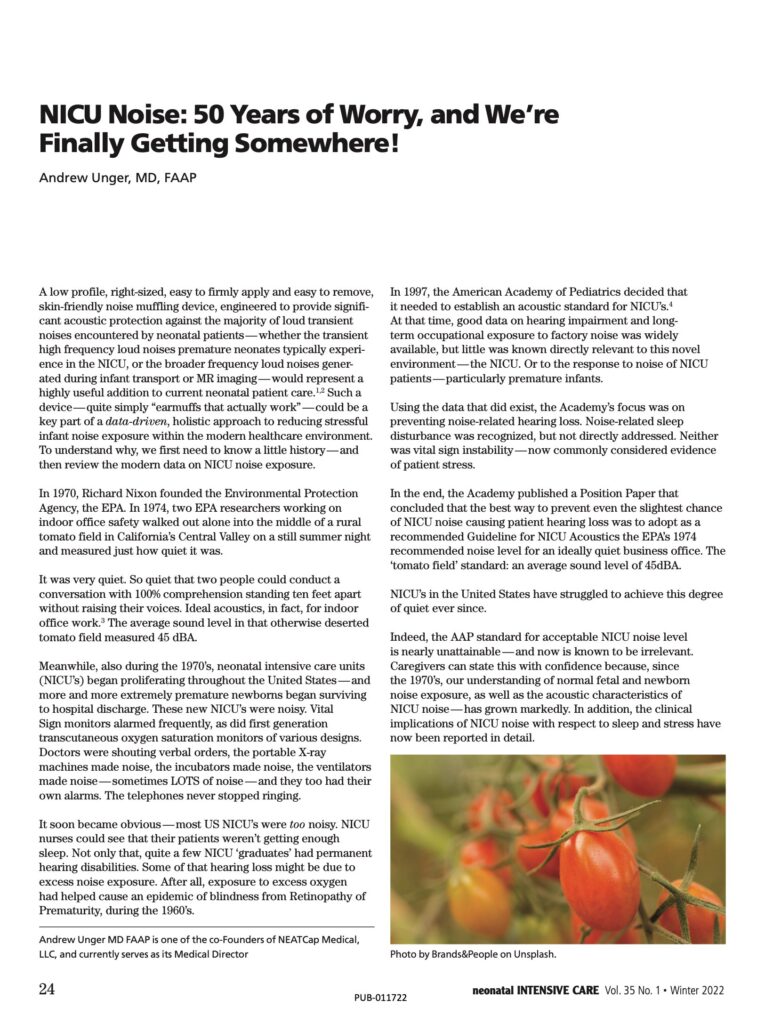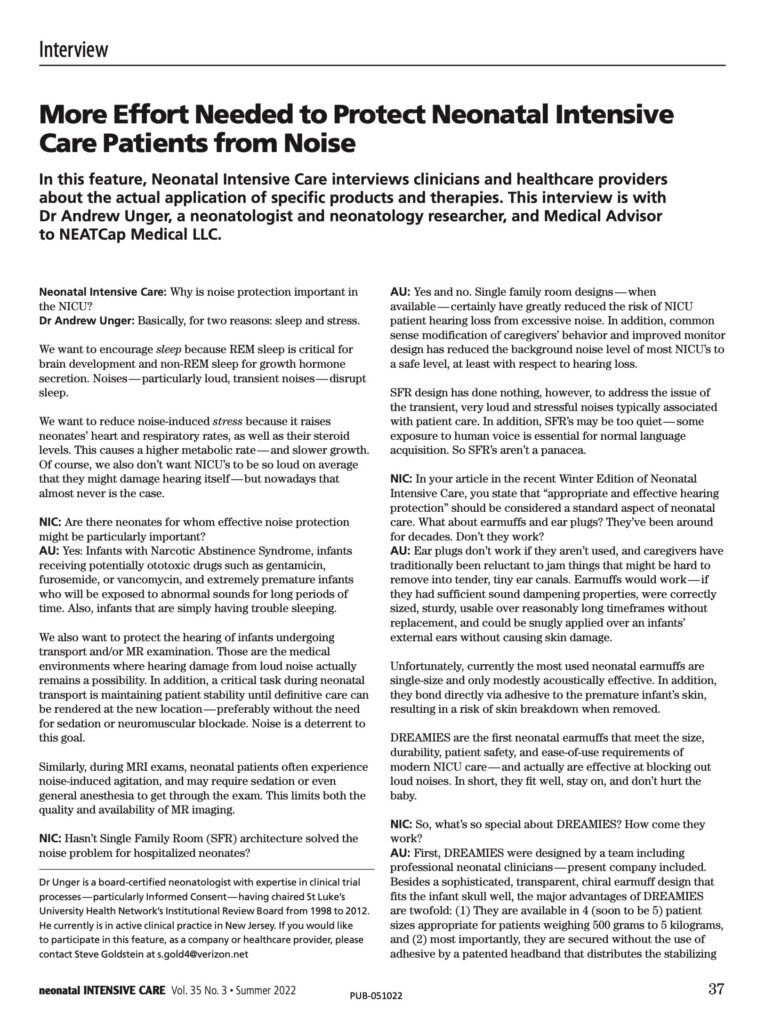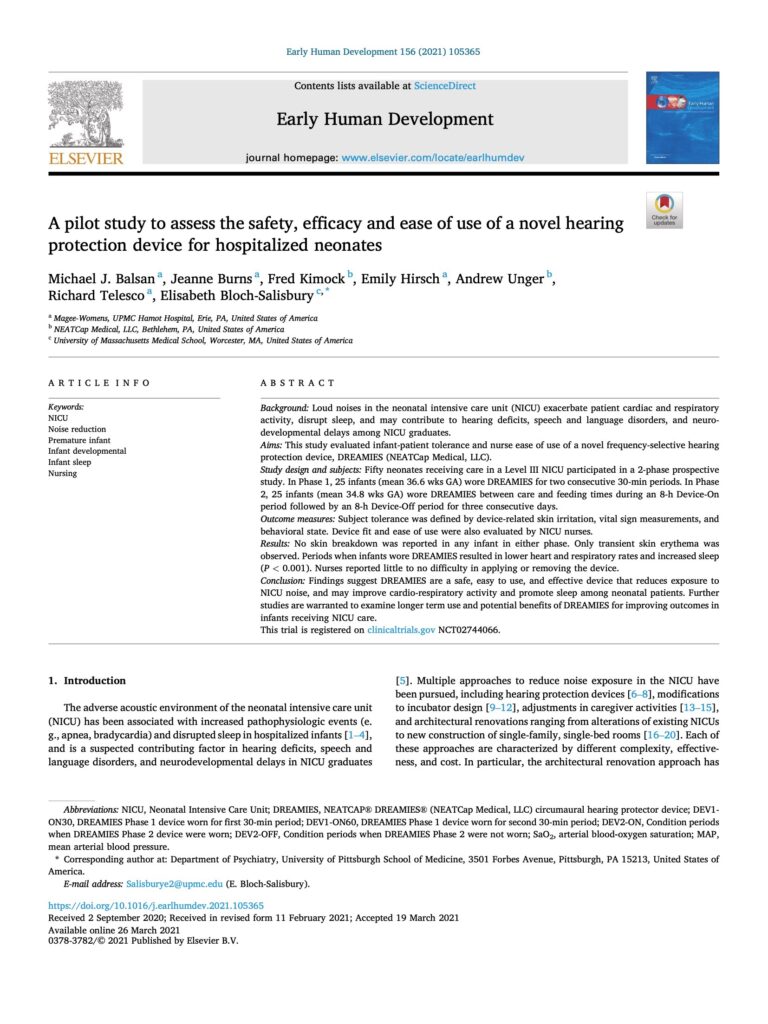
Experts




NEATCap Medical- A Manufacturer of Advanced Hearing Protection for Hospitalized Newborns and Infants.
NEATCap Medical- A Manufacturer of Advanced Hearing Protection for Hospitalized Newborns and Infants.
NEATCAP DREAMIES are a family of Hearing Protection Devices designed with unique FORM, FIT and FUNCTION specifically for infants undergoing Intensive Care in Noisy Hospital Environments
DREAMIES – NICU/PICU care of Preemies, NAS babies and infants
DREAMIES performance mimics the noise protection of mother’s body during pregnancy – blocking high-frequency alarms band equipment noise while allowing parent to child communication. Overall Sound Attenuation 19 dB.
DREAMIES T-M – MR Safe with high sound blocking for MRI
DREAMIES T-M have maximum sound blocking where MRI noise is the loudest. Rigorously MR Safety tested by a premier clinical research facility. Overall Sound Attenuation 27 dB.
DREAMIES T-M – Air and Ground Transport Noise Protection
DREAMIES T-M block noise across the full spectrum of sound, including the critical low frequency engine and road noises that dominate the transport environment. Overall Sound Attenuation 27 dB.


Uniquely Designed for Clinical Use with a highly vulnerable patient population
DREAMIES and DREAMIES T-M were designed and developed by a team of experienced neonatal clinicians and product design experts, and clinically validated in NICU, Transport and MRI environments by leading hospitals.
DREAMIES are designed for Continual, Recurring Single Patient Use in the NICU or PICU.
DREAMIES T-M are designed for short-term, recurring single patient use in hospital transport and MRI examinations.
NEATCap Medical has spent years of research working with clinical professionals to develop leading-edge products that provide comfortable, effective hearing protection solutions for neonatal and small pediatric patients. We have measured and tested our products within critical, noisy clinical environments - NICU, Transport and MRI.
Progressive Sizing: fits the full range of premature infants to pediatric patients up to age 2.
Rather than taking a “one size fits all” approach, DREAMIES and DREAMIES T-M are provided with Progressive Sizing (5 sizes) to specifically fit the entire population of preemies to full-term newborns up to age 2 undergoing hospital intensive care.
Unique features include:
Transparent, chiral, contoured ear cups.
Transparent, chiral, contoured ear cups that match the shape of an infant’s head with a soft foam seal make it easy to verify proper fit and inspect the ears
Unique flexible headband.
Unique flexible headband holds ear cups in place with smooth silicone patches that gently grip the skin without damaging the infant’s skin and head
Integration with best-practice patient care protocols.
Low profile ear cups and flexible headband allow integration with best-practice patient care protocols, and patient positioning (not just mid-line)
DREAMIES T-M are MR Safe.
DREAMIES T-M materials are non-metallic, non-electrically conductive, and non-magnetic

DREAMIES and DREAMIES T-M Sizing Reference Chart
DREAMIES progressive sizing ensures the proper fit needed to block noxious noise allowing the patient to rest comfortably in whatever hospital environment they encounter. DREAMIES really work!

Excess noise has been associated with physiological instabilities.
Excess noise has been associated with physiological instabilities in infant heart rate, respiratory rate, blood pressure, blood oxygenation, disrupted sleep [N5, N7-10], and behaviors that mimic acute pain stress responses [N11-13] and is a suspected contributing factor in neurodevelopmental delays in NICU graduates [N14].
High sound levels during air and ground ambulance transport have been associated with increased heart rate in neonatal patients during ambulance transport, a potentially adverse change that may reflect increased stress [T5]. The emphasis of hospital transport is to safely move a patient while maintaining physiological stability (vital signs).
Loud noise generated by the MR scanner can elicit autonomic instability, as reflected in cardiac rhythm changes, in neonates [M3, M4] and patient agitation resulting in motion artifacts in the scans. Sedation is frequently used to calm infant patients during MRI studies [M5].
DREAMIES T-M block noise across the full spectrum of sound, including the critical low-frequency engine and road noises that dominate the transport environment.
DREAMIES T-M have maximum sound blocking at frequencies where MRI noise is the loudest. DREAMIES T-M are MR Safe based on testing by a premier MR Safety testing laboratory.
Applications We Support – and WHY
DREAMIES and DREAMIES T-M provide a quiet environment which may help maintain physiological (vital signs) stability during NICU/PICU care, hospital transport and MRI examinations. In each environment, DREAMIES block the noise that matters.

DREAMIES – for Noise Protection during NICU or PICU Care
Routine NICU (or PICU) care occurs over a period of weeks, in a sound environment characterized by times of near-quiet and voice communication, disrupted by loud, high-frequency noises, e.g. alarms.
In 2 independent studies, premature infants and NAS babies were calmer, slept about 15% longer and had increased REM sleep when they wore DREAMIES [E9, E10]. REM sleep is critical to neurological development.

DREAMIES T-M – for Noise Protection during Air and Ground Transport
Hospital transport involves acute exposure to loud noise over a period of hours. Air and ground transport are characterized by nearly continuous, loud, low-frequency noise.
Clinical study results showed neonates who wore DREAMIES T-M had stable vital signs, and were calm without visible signs of distress during air and ground ambulance transport [E14, E15].

DREAMIES T-M – for Noise Protection during MRI
MRI exams involve acute exposure to loud noise over a period up to 1 hour. MRI exams create loud noise at low sound frequencies and very loud noise at mid-range sound frequencies.
Clinical study results demonstrated longer, motion-free MRI scans without sedation [E13].
Clinical Studies & Articles
NICU Nurses Love DREAMIES!



During the study we had positive comments from the NICU nurses and parents about the positive effect of the NEATCAP device.
Jeanne Burns, MSN, RNC-NIC
NICU Director
The NEATCap device was very helpful and the babies were much more calm with them on.
Alena Costello, BSN
NICU Nurse
It helped the babies rest more peacefully and they looked more comfortable in between care with lower heart rates and lower respiratory rates.
Lauren Martin, BSN, RNC-NIC
NICU Nurse
We had no issues getting the NEATCAP on and they were much calmer during the night with the NEATCAP’s on them and they seemed to tolerate it really well.
Deana Lasher, RN
NICU Nurse










